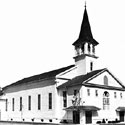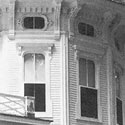The History of Allegan County, Michigan
Click photos below
for expanded views

| 
|
Bordering on Lake Michigan, Allegan County is located in the southwestern portion of the Lower Peninsula. It features varied historic sites including several gracious old churches. The origin of the county name is uncertain. It may be derived from the Indian word "Allegawi" or "Allegans" referring to a tribe of so-called "Mound Builders" or from an alternate name for "Cherokee." We do know that Allegan County was organized in 1835, a time of rapid settlement in Michigan. Its 1837 population was 1,469; that figure jumped dramatically to 32,381 in thirty-seven years.
The county's source of waterpower attracted eastern capitalists. For many years steamboats plied the Kalamazoo River between the communities of Allegan and Saugatuck. Extensive lumbering during the nineteenth century in Allegan County cleared the land for agricultural use. Even today, the county harvests large quantities of fruit and vegetables which bolster its economy.
Allegan's people and buildings reflect this varied history. A small portion of the famous Dutch-American community of Holland is located in the county: the nearby Graafschap Christian Reformed Church, listed on the State Register, is an 116 year old reminder of the area's Dutch presence. Other county houses of worship on the State Register include the Allegan Episcopal Church and the Seventh-Day Adventist Church, both in the city of Allegan. Also in that community is the Old Wing Mission. The main portion of the structure, erected in 1844-45, was the home of George N. Smith, a Congregational missionary to the Indians in this area. The city of Allegan features the English Gothic style home, ca. 1867, of General Benjamin Pritchard, a Civil War hero noted for his capture of Jefferson Davis, and the Italianate style Delano House built in the latter part of the nineteenth century by county pioneer David D. Davis. These structures embody pieces of the area's history. An official State of Michigan marker reminds us of a no longer visible story: the ghost town of Singapore, Michigan.
Beneath the sands near the mouth of the Kalamazoo River lies the site of Singapore, one of Michigan's most famous ghost towns. Founded in the 1830's by New York land speculators, who hoped it would rival Chicago or Milwaukee as a lake port, Singapore was in fact, until the 1870's, a busy lumbering town ...
Ghost towns and all, Allegan County's history dates back quite a bit further. The first people to live in Allegan County were Indians who camped by rivers and lakes swollen with the runoff of the melting glaciers 11,000 years ago. They left behind long flint spear points of a distinctive style that they may have used to hunt the mammoth and mastodon, which roamed the area at that time. As the climate changed and the Ice Age animals died off, the Indians became adept at the hunting of smaller game such as deer and the gathering of roots, berries, and nuts in a seasonal cycle. This way of life continued for millennia.
Crops such as corn and squash, originally domesticated in Mesoamerica, were probably grown in southern Michigan by AD 700-800. By that time, the Indians were using the bow and arrow and had been making pottery for about a thousand years. Garden products supplemented their diet; they did not become staples until some time later. From about AD 1300 on, the Indians of southwestern Wisconsin adopted a life style similar to that of their neighbors in Indiana and Ohio. Horticulture became more important. People spent most of the summer and fall in villages, and at other times moved to small camps convenient to hunting grounds, fishing stations, maple groves, and so forth. The circular earthworks found along the Rabbit River are the remains of palisades built to protect small villages sometime after AD 1000.
We sincerely thank Michigan History Magazine for granting reprint rights to this article, originally appearing in the Sept/Oct 1978 issue. To subscribe, click Michigan History Magazine.
|